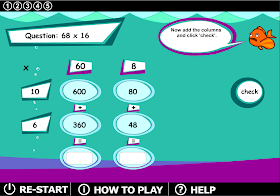January 2020 update: It looks like this game is no longer available! If you find it again or it goes back up please comment below! In the meantime, we have been loving this free app for looking at area model!
I am a big fan of using the area model to teach multiplication. Starting at the fact level and working up through multiplying polynomials, the area model is a great way to anchor understanding and help students see how multiplication is all connected. If you want to learn more, check out this post about using the area model to teach mixed number multiplication. You can also check out this post where I write about fourth graders using QR codes along with arrays and partial products to practice double digit addition.
As I try to keep kids busy and learning when I am meeting with small groups, I often look for really good computer activities or games to keep kids motivated. I have had a hard time finding practice online for area model type multiplication. However last year I stumbled upon this gem. I ended up using it in grades 3-5 but my fourth graders definitely used it most!
The Amoeba Multiplication Game
 |
| The game is offered at 3 different levels. Level A is two digit by one digit. Level B is double digit and Level C is three digit by two digit. |
 |
| Level A waiting for the student to find the sum. |
 |
| Level B. The student has entered the partial products and hit check. Now they need to find the sum of the 2 parts and hit check again. |
 |
| Level C |
 |
| Level C. Here is what happens when you hit check and one of your answers in incorrect. A purple box appears around it and it asks you to try again. |
My students liked that they got to use the computer and kept referring to this as a game. I see it as more of an activity then a game but the kids really seemed to enjoy it. My favorite part is that kids get the extra practice they need and get immediate feedback if they are wrong! There is nothing worse than a kid practicing math the wrong way!
If you know any other great games for practicing multi-digit multiplication leave a link in the comments below!
If you are looking for another fun way to practice these important skills you might want to check out this QR code scavenger hunt!
 |
| Looking for more double digit multiplication practice? This low prep activity has over 120 positive reviews! |


























